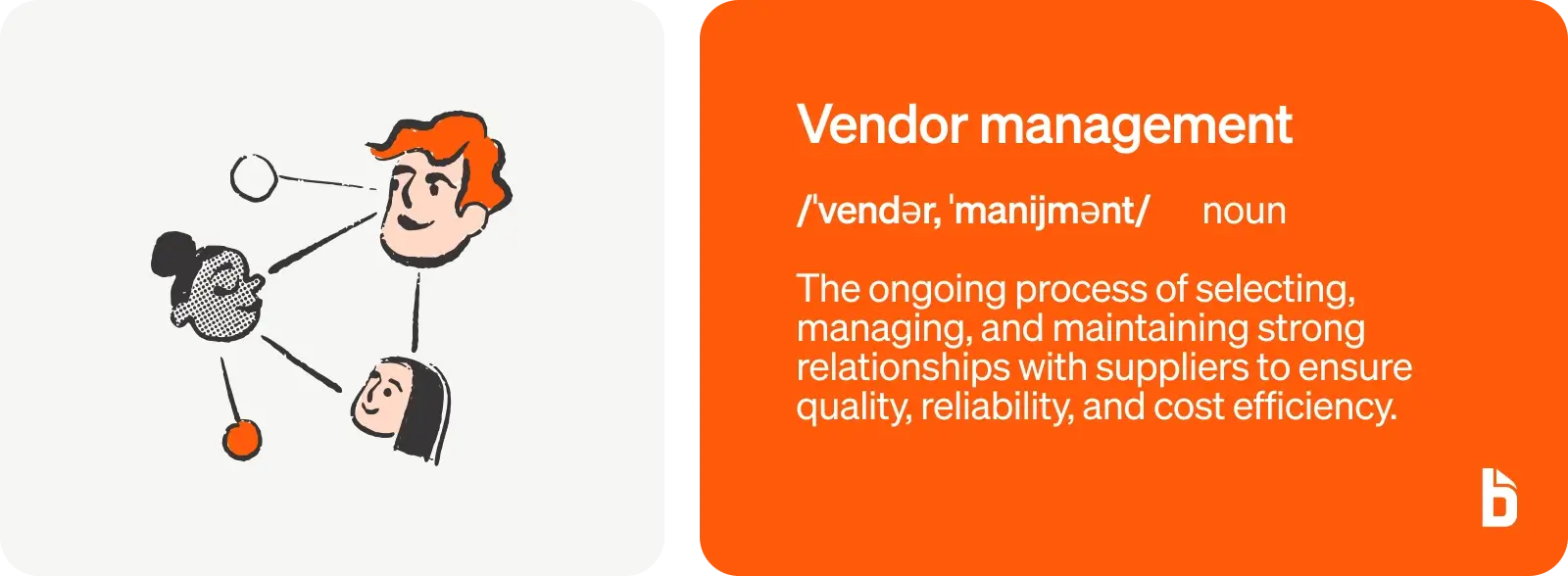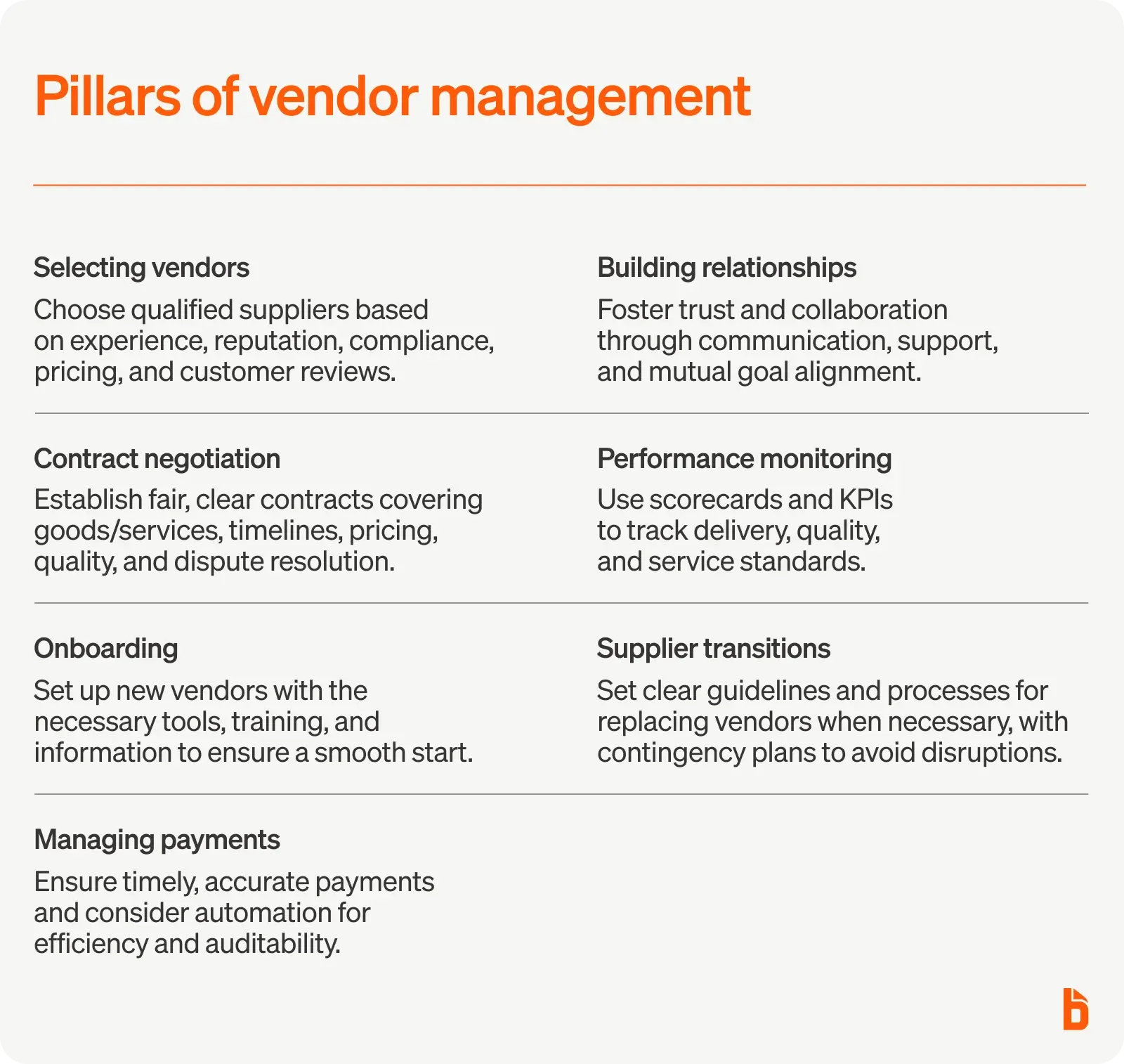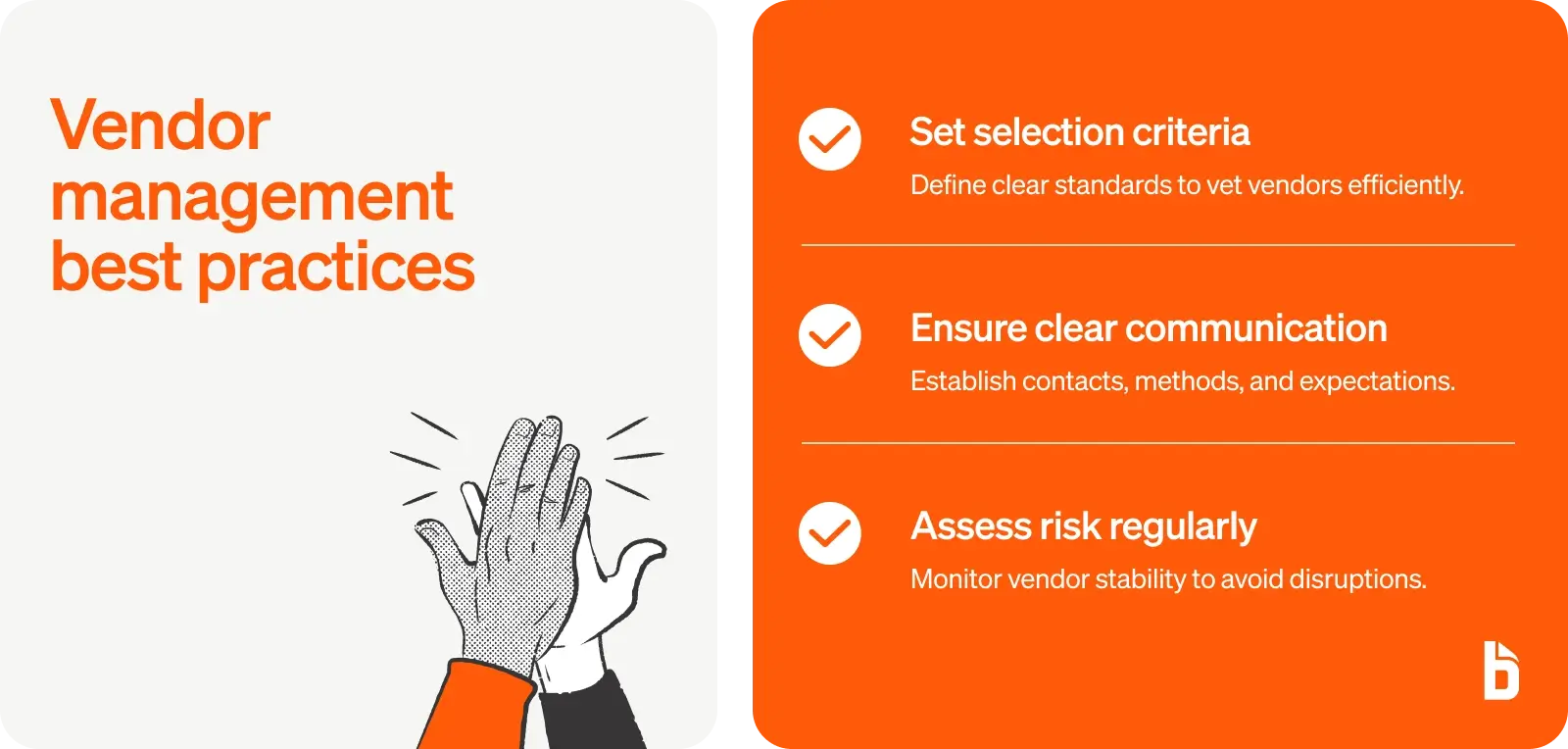As your business grows, managing multiple vendors can quickly become a headache.
You need to take care of the basics, like making sure payments and deliveries are made on time.
But, effective vendor management also requires you to take a deeper look at your suppliers to ensure they’re helping you meet your business objectives and providing products and services at a good value.
Vendor management doesn’t have to be a burden that your team shies away from.
Instead, it can be a strategic tool to help build collaborative and supportive long-term partnerships with your suppliers.
Read on to find out how!

What is vendor management?
Vendor management is the process of onboarding, managing, and building relationships with vendors or suppliers.
There are many advantages that proper vendor management can provide for your business.
Namely, it helps you ensure you’re working with vendors that are cost-effective and supply quality goods or services.
Going further, the vendor management process fosters strong relationships and trust between you and your suppliers.
In turn, this can strengthen your supply chain, helping you minimize costly disruptions and work with vendors that are reliable and efficient.
In sum, the vendor management process does not merely consist of a checklist that you can quickly tick off when you have the time.
It’s a continuous process that your accounts payable (or sometimes procurement) department must adopt to help you improve product and service quality, build vendor loyalty, and stay cost-efficient.

The pillars of vendor management
Vendor management is a multi-faceted practice that starts before you even sign a new supplier contract.
When done effectively, it helps you build a supplier base that is reliable, cost-effective, and supports your goals.
With that being said, here are the main components of an effective vendor management system:
Selecting qualified vendors
The first step of the vendor management process is to select vetted and qualified vendors.
Though this may sound easy enough in theory, you must perform some initial research to assess potential vendors and compare them against your set criteria, which we’ll describe in more detail below.
You can also consider asking industry peers for recommendations where appropriate.
There are a variety of factors you can use to evaluate vendors during this initial stage, including:
- Reputation in the industry
- Years of experience
- Relevant certifications/licenses
- Background checks
- Pricing
- Capabilities
- Compliance practices
- Customer reviews
If you put some time and effort into selecting the right vendors from the beginning, you can set yourself up for success by working with suppliers that are reliable and qualified.
Negotiating contracts
Once you’ve selected the vendors you’d like to work with, the next step in the vendor management process is to negotiate a fair contract.
Supplier contracts spell out clear and important details that form the basis of the engagement, including:
- The goods or services to be delivered
- Delivery schedule
- Duration of the engagement
- Pricing structure
- Quality standards
- Preferred method of dispute resolution
- Other terms and conditions
Though you want to negotiate a contract that is cost-effective and favorable to your business, you also want to form a win-win situation that supports the vendor’s business and starts your relationships off on the right note.
Negotiations can be a delicate balance if you want to come to a fair agreement, though it’s worth it in the long run if it leads to a long-standing partnership that both parties are happy with.
Creating a consistent onboarding process
After signing the contract, your supplier onboarding process helps you set the right first impression with new vendors.
Onboarding can occur through a dedicated onboarding software program.
Or, it may be a process you walk them through manually.
Overall, thorough onboarding ensures you’ve exchanged the necessary information to add the new vendor to your system and start making payments.
During this stage, you can further clarify any expectations outlined in the contract to ensure you’re both on the same page about the timeline and deliverables.
If any training is required on your end to help integrate the supplier into your system, this is when it should occur.
Your onboarding process should be comprehensive and provide the supplier with everything they need to collaborate with your business and successfully meet your expectations.
Managing payments
As you start to work with more vendors, processing invoices and managing payments becomes a more involved process.
No matter how many vendors you’re managing, your team wants to avoid making late payments and ensure you’re taking advantage of early payment discounts when possible.
Plus, you need to assess past invoices to monitor changes in amounts owed and keep track of any updated billing data from the supplier as part of the invoice audit process.
Managing payments manually may be straightforward when you have just a handful of suppliers to take care of.
However, once your business grows and you start to deal with dozens of vendors or more, your team may benefit from an automated accounts payable software solution (like BILL) to keep you on track.
For instance, you can use BILL to ensure payments are made on time and spot changes in invoice data over time for auditing purposes.
Supporting vendor relationships
Strong, long-term vendor relationships can encourage innovation, loyalty, and quality from the supplier, making it an important aspect of your business’s vendor management system.
When a vendor is facing supply chain issues or shortages, a strong relationship can be the difference between them prioritizing your shipments over other customers, or pushing off your delivery until their inventory levels have normalized.
You may be tempted to think you’re treating vendors well simply because you always make on-time payments.
However, to manage vendor relationships effectively, it requires a more strategic approach that establishes collaboration and trust between your two organizations.
Here are some of the ways that you can support better relationships with vendors:
- Pay vendors on time
- Be open about your business goals and objectives where appropriate
- Leave a good review for vendors that have exceeded expectations
- Set up clear communication channels
- Communicate possible issues that the vendor can correct
- Visit your vendors’ facilities
- Invite your vendors to special webinars or events
- Make referrals to help grow the vendor’s business
- Ask for feedback from your vendor about improvements you could make
Monitoring vendor performance
A crucial aspect of vendor management is using a vendor scorecard to monitor suppliers and help you evaluate their performance on an ongoing basis. Your scorecard might include metrics like:
- Percentage of orders delivered on time
- Defect/error rates in delivered goods
- Rating of the vendor’s customer service
- Cost per unit
- Lead times
- Response time between a complaint and resolution
Tracking these metrics can provide your team with the objective data they need to make supplier decisions and determine when it’s time to find a better alternative.
At the most basic level, your team should make sure suppliers are meeting their contractual obligations.
For example, if a supplier agrees to deliver three pallets of goods on the first Friday of each month, your team should keep tabs on this and note any consistently late deliveries or incorrect quantities.
While this may seem straightforward and easy to track, when you’re managing dozens of vendors at a time, these specific details can get lost in the noise.
Even if the vendor is making timely deliveries, tracking data like the defect rate for delivered goods can paint a different picture that may impact customer satisfaction and complaint rates.
In other words, how many defective items per pallet do you deem reasonable or acceptable?
Establish and monitor key performance indicators (KPIs) and other metrics to help you evaluate your vendors for quality and efficiency.
Establishing guidelines for when/how to change suppliers
Similarly, your metrics should guide your process for determining when it’s time to change suppliers.
If you’re facing ongoing issues that are not properly addressed by the vendor, the data you’ve documented may be grounds for terminating your contract.
Do they consistently make late deliveries? Is the defect rate per delivery above your expectations? Is the quality of goods not up to your standards?
Create clear guidelines for your team to use as a basis for ending vendor relationships.
Maybe you give your vendors a three-strike policy, or something similar, that can be applied fairly to all vendors.
But, ending a supplier relationship doesn’t always have to be based on the vendor’s errors.
Sometimes, you may discover a new vendor that offers a better pricing structure. Or, maybe your business needs have changed and you no longer need their goods or services.
Either way, make sure you have a formal process in place for your team to evaluate vendors and address concerns on a frequent basis–like quarterly or annually.
With this, you should have a contingency plan in place to avoid business disruptions as you transition to a new supplier.

3 best practices for better vendor management
Before you review your own vendor management process and make possible adjustments, review these best practices to steer you in the right direction:
Create vendor selection criteria
Internally, you should establish specific criteria and qualifications for choosing new vendors.
Depending on the nature of your business and the industry you operate in, these criteria can vary to fit your specific needs.
However, the general factors you may want to consider include a vendor’s qualifications, expertise, experience, and pricing.
Based on your experience, you may determine that you only want to work with vendors that have been in business for at least three years, as you’ve gathered they tend to be more established and reliable.
Or, you may have specific pricing levels that vendors must meet to support your overall financial goals.
In any case, having clear vendor selection criteria can help your team streamline the process of vetting potential suppliers, which you can alter and refine over time as needed.
Here’s a template you can use to evaluate potential vendors. Rate each potential vendor on a scale of 1-3 for each criteria. Feel free to add other criteria that are important to your business as well.
Maintain clear communication
Any successful relationship hinges on having clear and effective communication–even in the business world.
You should have clear communication channels and a point of contact set up between your company and the vendor for seamless communication.
Part of your onboarding process should include clearly defined expectations, like:
- Your point of contact
- Your preferred method of communication
- How frequently you expect to receive communications from the vendor
- Expected response times to questions/concerns/inquiries
- How you will handle disputes
Evaluate your risk exposure
Be aware of the risk factors associated with your vendors so you can be proactive and avoid business interruption.
While vetting vendors, you may want to ask about their financial health, who their suppliers are, their outlook for the market, and any other risk factors that may be relevant to your industry.
A comprehensive vendor management process should help you mitigate supplier risk by helping you create relationships with dependable and qualified vendors.
However, vendor circumstances may change, so it’s important to be aware of your risk exposure so you can make adjustments as needed to maintain a diverse supplier base that supports business continuity.
Ready to upgrade your vendor management process?
The vendor management process can be tedious and time-consuming, especially as you start to expand operations and add more vendors.
Even still, it’s a necessary process that helps your business mitigate supplier risk, ensure business continuity, and maintain relationships with reliable and cost-effective vendors as you scale.
Using a tool like BILL’s AP automation software makes it easier to pay vendors on time, while your team focuses on the other critical aspects of the vendor management process.
To see how automation can help upgrade your vendor management practices, get started with BILL!


